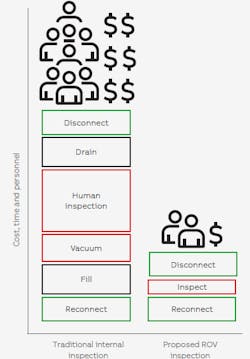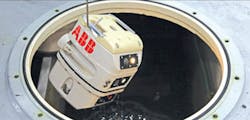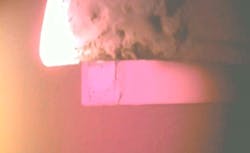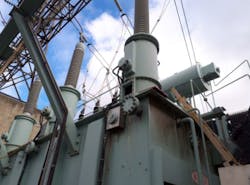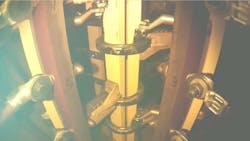Oil-Filled Power Transformers: Time for Robotic Inspection?
Power transformers are one of the most critical and expensive assets in electric transmission and distribution. An in-service transformer failure can have far-reaching consequences: extended outages, costly repairs and potentially serious injury or fatality. The majority of transformers in service were installed before 1980. Most are either approaching or have exceeded their original design life. That poses a significant risk for utilities and other power network stakeholders. An in-service transformer failure can lead to oil spillage and become an environmental disaster. To improve the reliability of the existing power transformers and decrease maintenance costs, monitoring and diagnostic techniques have become crucial. If a transformer has operation issues, the best approach is to start with external observation and electrical tests. If tests and oil analysis indicate that the transformer is in normal condition: great. If, however, an abnormality is detected, the next step is an internal inspection.
An internal inspection identifies the issues. The device owner can then be told whether the transformer is repairable onsite or needs to be sent to a workshop for further assessment.
An internal inspection traditionally starts with draining the oil into clean IBC tanks. Breathable air must be added and a confined-space rescue team assembled before sending a transformer expert inside the unit for inspection. Not only is this approach extremely costly and time-consuming, but it also puts at risk the transformer’s internal components and the people entering the confined space. Those entering the transformer are susceptible to inhaling dry air, getting injured with sharp objects, and slipping on the oily surfaces and falling. Inspection risks to transformers include moisture ingress, the introduction of foreign objects and damage to the device if the inspector is not experienced and cautious enough.
Figure 1 shows a comparison of the traditional internal examination with the proposed robot inspection. The latter eliminates the need for processing equipment such as ISO tanks, processing and vacuum filling or personnel to remove and store oil, which is necessary during a human inspection. Table 1 shows the time spent and resources used to complete a single internal inspection on 600-MVA, 500-kV and 30-MVA, 132-kV transformers.
To mitigate these issues and speed up the internal inspection process, ABB’s Transformer Services has developed a solution that internally inspects a power transformer while it is still filled with oil: an untethered remote-controlled robot that facilitates the visual inspection of the transformer’s internal components by a transformer expert. This way, the issues can be identified and the transformer returned to service the same day. As a result of this inspection, future actions can be planned and executed with the knowledge of what the repair team will encounter or whether a future outage and oil handling will be needed. This also makes an inspection a routine process—update the baseline and conduct periodic testing of the transformer. Photo and video information collected by the submersible can become part of the baseline to be used in future inspections. This material is shared as part of the panel presentation.
This paper aims to validate the utility of the remote internal inspection performed by the ABB AbilityTM TXplore inspection robot and present cases of internal inspections performed in Australia.
Case Study 1
Simcoa Operations is an Australia-based company that produces high-quality silicon.
The company sought the expertise of ABB Australia’s Transformer Service team to perform an internal inspection for one of their 132/22/11-kV power transformers made in 1987. They wanted to address concerns regarding high levels of heat gassing trends emanating from their transformer. According to oil test results from mid-last year to April, the transformer experienced discharge of high energy and arcing because of a combination of thermal and electrical faults.
Simcoa Operations originally requested ABB to use the traditional method of inspection: transformer engineers/personnel entering a confined space for inspection after a lengthy process of oil drainage. This approach would have taken five days of round-the-clock work and posed safety concerns. There would also have been limitations to what internal areas of the transformer would be visible while inside the unit.
ABB’s engineering team introduced the TXplore, the world’s first submersible transformer inspection robot, which can be manoeuvered through a power transformer without removing oil or sending a person into a confined space. The TXplore enhances safety with reduced risk to personnel, shortens downtime with the inspection being performed in hours instead of days and brings down inspection costs by about 50%.
At the start of the inspection, it was found that the color code of the transformer oil was at level three, meaning the oil was dark brown, unclear and high in density. This hampered the vision of the cameras on the robot. But despite poor visibility, the robot was able to swim through tight areas and capture and investigate faults in the transformer using its onboard high-resolution camera and LED lighting system. According to DGA test results, the source of the heat gases was bad tap-changer connections. In the Txplore photos from the tap-changer site (Figure 2), no specific hot spot or source of acetylene stood out.
Figure 3 shows that the insulation of star-point connections on the LV winding was discolored and damaged because of high temperature. The acid formed sludge deposits on the winding leads, resulting in reduced heat dissipation. The winding leads ran hotter and hotter, creating more sludge and subsequently more heat. The sludge slowly built up on star points and the temperature continued to increase over time.
High acid content and increased temperatures accelerated the deterioration of the insulation quality. If left untreated, this would have resulted in reduced transformer life expectancy and could also have been the source of Acetylene (Figure 4).
The robot operators were able to inspect all parts and critical key internal components of the transformer. The compact size and manoeuvrability gave way to easy viewing of the connections on the low voltage side, tap-changer connections on the high voltage side, active part, internal tank wall, bushing connections and the bottom of the tank.
During the inspection, photos and videos taken were streamed live to ABB’s transformer engineers and the Simcoa Operations team. The visual acknowledgement provided the evidence needed to make informed decisions about their next steps.
ABB’s inspection of the transformer was a critical activity for the customer, both in terms of ensuring minimal shutdown, and quickly and safely identifying faults. Simcoa Operations had only a one-day shutdown for this inspection. During this time, they lost 30% of their production line. ABB concluded that the transformer could be energized and brought back to service the same day since the source of heat gases would not stop the power device from operating properly. A comprehensive report was submitted to the customer with all the findings along with recommendations.
Case study 2
AusNet Services, an Australian energy company, asked ABB to perform the internal inspection of one of their transformers. There were concerns regarding possible corrosive sulphur on tap-changer contacts and rings. The transformer had three windings: 230/67.5/22.5-kV for 100 MVA/150 MVA with ODAF cooling classes. Using TXplore, AusNet’s maintenance team wanted to find out how much damage had taken place on tap-changer contacts. The inspection started with reviewing the transformer design and the latest DGA test result. The hatch on the HV bushing turrets near to the tap-changer was opened to reach to the top of the active part and the tap-changer (Figure 5).
Accessible portions of the leads, connections to the tap-changer, areas around the bottom core clamp and feet were examined to find signs of damage or overheating. Some black color was seen on the core frame and debris was observed at the tank bottom. It appeared to consist of plastic material, papers, and sludge particles (Figure 6). But no specific hot spot or insulation discoloration was observed (Figure 7).
Corrosive sulphur was seen on a number of current collector rings in the tap-changer. Figure 8 shows that silver rings likely reacted to form a silver sulphide coating, while selector contacts (copper) were left intact.
Precise and clear photos taken during the inspection were submitted to the AusNet team immediately after the procedure. The team was able to observe the severity of the corrosive sulphur damage on their tap-changer rings. They could now get the right diagnosticians to deal with the issue and plan for tap-changer maintenance accordingly. The whole inspection took less than two hours.
Internal transformer inspection can be performed safely by remotely operated robots without exposing personnel and transformer internal components to risk. This also drastically reduces the cost and time of inspections compared with a traditional inspection that requires multiple team members, specialized equipment and several days.
Results from the provided real-life examples prove the capability of ABB’s TXplore robot. This innovative inspection technology can access complex areas such as the bottom of windings, the core structure, leads and tap-changer connections that are impossible to reach for human inspectors.
Submersible remote robot inspections can improve internal inspection of transformers in multiple ways. First, safety is enhanced by eliminating the need for humans to enter confined spaces and harsh environments. Environmental safety is also enhanced as there is now no risk from oil spills. Second, immediate deployment and considerable reduction in outage time from weeks to days expedite fault detection. The inspection can be accomplished during an outage of less than a day. Also, the images and videos collected can be shared live onsite and even remotely across the globe with multiple engineers and experts and kept as a baseline for future inspections and repairs. This is a total game-changer when it comes to transformer inspections.
About the Author
Naser Hashemnia
Transformer Intelligence Engineer
Naser Hashemnia received the B.S. degree in Electrical Utility Engineering 2008 and Ph.D degree in Electrical Power Engineering in 2014 in Australia. He joined ABB Power Grids Transformer business as Transformer Intelligence Engineer. He is responsible for developing the full Transformer Intelligence Portfolio in Australia. He implements marketing strategies to develop service solutions aimed at addressing problems with transformer products such as Advanced Diagnostics and Asset Management solutions by means of condition monitoring systems with predictive analytics and support sensor and monitoring technology.
His expertise is transformer condition monitoring and application of artificial intelligence to power systems. He is a regular reviewer for IET Generation, Transmission and Distribution and Engineers Australia technical journal.

